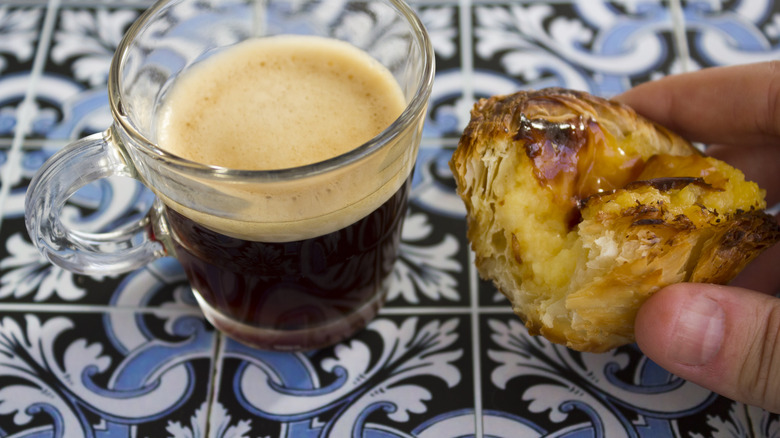How To Order Your Favorite Coffee In Portugal Like A Local
Brimming with top-tier European foodie destinations you'll quickly fall in love with and lesser-known cities with unmatched views, Portugal has its own set of customs and terminology when it comes to their coffee and pastry culture — some of which might leave even the most seasoned caffeine enthusiasts reeling. Because, while you might be used to ordering a simple latte or espresso back home, stepping into a traditional Portuguese cafe opens up a whole new world of terminology and traditions that can feel both exciting and overwhelming if you're not sure what you're doing.
After all, in Portugal, coffee isn't meant to be just an on-the-go beverage — it's a way of life that requires time and dedication. From the tiny but powerful "bica" to the creamy "galão," traditional Portuguese coffee comes in all sorts of shapes and sizes — each one with its own special name you probably won't hear anywhere else.
Ultimately, this unique way of doing things not only means that you'll need to learn a whole new coffee vocabulary — which can be a little scary — but also that you might discover a whole new way to enjoy your favorite beverage during your Portuguese vacation. That's basically a win, if you ask us.
Understanding the local coffee terminology
Although Portugal might not top the list as one of the top destinations known for their coffee — the country doesn't truly grow coffee outside of a small farm in the Azores — it's still a proud purveyor of the beloved beverage, with the local coffee industry expected to generate roughly $3 million in 2024. From simple espressos to the more elaborate milk-based concoctions, Portuguese cafes offer a rich variety of options.
The most common out of the bunch is typically a "café" (aka, an espresso) — which is also known as a "bica" in Lisbon or a "cimbalinho" in Porto. From there, things can get a little complicated if you're not careful. For example, if you're after a stronger kick, go ahead and order an "abatanado" (similar to an Americano), an "'Italiana" (a short espresso), or a "carioca" (a shot of espresso with more water added to it). Alternatively, if you prefer less intensity, you can choose a "pingado" (an espresso with a drop of milk), "garoto" (mostly milk with a touch of espresso), a "galão" (the Portuguese version of a latte), or a "meia de leite" (equal parts coffee and milk). Most of these will come with sugar on the side as a given, so don't worry about asking for that.
While this all might sound confusing to start with, it's easy to get the hang of it once you've made it a habit to order your drink Portuguese-style. Plus, at the end of the day, learning these new terms can ultimately mean the difference between feeling like an outsider and blending in with the locals.
More Portuguese cafe tips for your travels
Not in the mood for caffeine? Try ordering a "chá" (tea) or, if you're more into the fruitier options, a "sumo de laranja" (orange juice) will do you just fine. Once you've settled on your drink of choice, the next step is deciding what you want to have with it. After all, no true Portuguese coffee experience is complete without one (or more) of the country's iconic pastries: from the popular "pastel de nata" (custard tart) to a "travesseiros" (sugary puff pastry stuffed with an even sweater filling) or a "queijada" (cheese tart), your sweet tooth is bound to be satisfied.
As for when to get your fix, it's worth noting that coffee — and its sweet little companion — is often enjoyed throughout the day in Portugal — not just in the morning. That said, don't be surprised if you see locals enjoying a café after lunch, or even well into the evening. If someone can handle their caffeine well, they'll definitely try and make the most of it. Want to blend in even more? Order and drink your "café" while standing at the counter (especially if you're in Lisbon).


